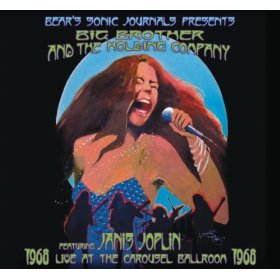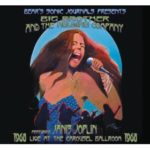
Columbia/Legacy
There are two things that need to be noted right off the bat about the new archival release from Big Brother And The Holding Company, Live At The Carousel Ballroom 1968.
First of all, the album’s magic has as much to do with the man who recorded the music as the musicians who created it. The brilliant Owsley “Bear” Stanley (who died a year ago – 3/12/11 – in a car accident in his adopted Australian homeland) was the Carousel’s soundman during its brief existence. Bear was a two-year veteran of the challenges of the Grateful Dead’s live sound when he created the Carousel’s system in the spring of 1968 and made it all work until Bill Graham moved in that fall and turned the venue into the Fillmore West. Stanley’s approach to sound was simple, in a way: get the best possible equipment available, modify as needed, and place it properly on stage for ultimate sound. Part of the process included the recording of “sonic journals” – live recordings captured for post-gig review of a given night’s sound. The aim was for the journals to reflect what the audience had actually heard; the mics were used as extensions of ears, providing a document of what went down, warts and all.
It’s important that you know all that because Live At The Carousel Ballroom 1968 is one of Bear’s sonic journals – not remixed from one, mind you: this is the way the music went down inside the four walls of the Carousel. As ol’ Walter Cronkite would’ve said, “You are there.” And it’s not just an authentic document of the history of psychedelic rock ‘n’ roll – it’s an amazingly well-recorded live album by anyone’s standards. Nudge yourself every now and then while it plays and remember that this was 1968 – the band didn’t even have monitors, for chrissakes – and grin and shake your head in wonder.
Did I use the word “magic” earlier? Yes? Well, here it is again: what you have here is some grade-A 100% pure Owsley Stanley magic.
Speaking of that monitor-less band, that’s the other thing you need to know about Live At The Carousel Ballroom 1968 : this is not Janis Joplin and her boys – this is a goddamn band, folks. This is Big Brother And The Holding Company: there’s no denying Janis’ ability to make you flinch with that voice – her blues-soaked larynx the human equivalent of a ’53 Fender Bassman amp on the verge of melting down – but there’s also so much power and talent and, well, fearlessness to be found in the sound of the band as a whole.
Take bassist Peter Albin, for instance: able to go way, way, way out there as needed (put an ear to the madness of “Light Is Faster Than Sound”, for instance, an Albin original); burrow into the core of a blues pocket (witness “Jam – I’m Mad”); or light the fuse on a Middle-Eastern-flavored sonic drama (his self-penned “Coo-Coo”), Albin is often the band’s navigator, knowing when to yank the stick back and pull the hurtling machine out of a scary spiral and back into a tune’s main theme. And I care not how many times you’ve heard how many versions of “Piece Of My Heart” – you need to listen to this one and pay particularly close attention to Albin as he climbs the emotional ladder of the choruses, his low-end bomp all a-tumble down the backside in sync with Janis’ vocal.
Albin’s rhythm brother is drummer Dave Getz, who works a very basic drum kit to its full potential – from the tie-dyed soul change-ups of “Flower In The Sun” to the sweaty sex of “I Need A Man To Love”. (For every tickle, squeal, wail, and moan that Janis’ vocal offers, Getz is right there with a slow thrust – damn dangerous drums, if you ask me.) And his work on “It’s A Deal” is a study in dynamics, going from straight-ahead slammer-bammer to a gentle tumble on the choruses.
Sam Andrew and the late James Gurley may be one of the most under-rated guitar pairings of all time – and Live At The Carousel alone would be enough to back that statement up. Note that I’m not even qualifying them as a rock guitar pairing … why would I? Dig Andrew (usually the cleaner of the two Gibsons you hear) on the opening charge of “Combination Of The Two”, getting all funky. Gurley, in the meantime, comes slamming in on the break with a thick, liquidy tone all slathered in fuzz, laying down a crazed jazzbo blow over top of the churning/rumbling Getz and Albin.
Andrew’s sweet “Call On Me” (offered here in a pair of versions from two different nights) is noteworthy for both his lovely guitar cascades and his soulful testifying duet with Janis. “Listen here,” he tells her on the final bridge of the album-closing version. “All right, Sammy,” she answers – sounding just about as playful as you’ve ever heard Janis Joplin. (Remember, folks: no monitors. Jesus … how did they do it?) His stuttering bends and wails on “Down On Me” are somehow over-the-top reckless and dead-nuts-on with the groove at the same time. And Carousel also contains a version of one of the greatest Andrew/Gurley workouts of all time: “Summertime”. Their swirling dance on the reworked Heyward-Gershwin classic is the ultimate in psychedelic Baroque; an orchestrated effort that turns on a dime while still coming off wild and tension-filled.
And throughout it all, there’s Janis Joplin, rest her soul. Her voice is as powerful as any of the instruments wielded by her bandmates: syllables worked into the crevices of the beat; growls that take over where the words leave off; and wails that ring right to the core. She brings it down to a sultry rap in the middle of “Catch Me Daddy” that would rival the raunch of Pig Pen at his best without coming right out and saying, well … anything bad, really. On the 9:22 version of “Ball & Chain” offered here, Janis’ ache-filled moan is the only thing that could possibly come in on the heels of Gurley’s tortured guitar break and hold its own.
It’s a powerful song; it’s a powerful album.
There is much mention made of Owsley Stanley’s recording technique in the Carousel liner notes. Basically, the PA (vox and drums) went into the left channel and everything else went into the right with little bleed between the two. The result isn’t your typical stereo audio airbrush: it’s hot, immediate, and real as hell … as close as you’re ever going to get to being on the floor at the Carousel without building your own acid-fueled time machine.
In his short essay entitled “How To Listen To This Album” sound guru John Meyer (Meyer Sound Laboratories) suggests moving your stereo speakers as close together as possible to achieve a single-point-source sound. That’s all well and good, but I can tell you this right now, boys and girls: all you’ve got to do is leave your speakers right where they are and turn Live At The Carousel up loud – it’s gonna sound just exactly perfect.
Glass raised to you, Bear. Thank you, sir.



No Comments comments associated with this post